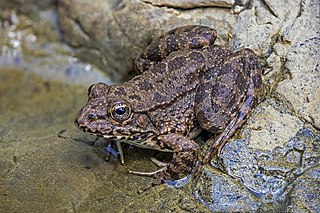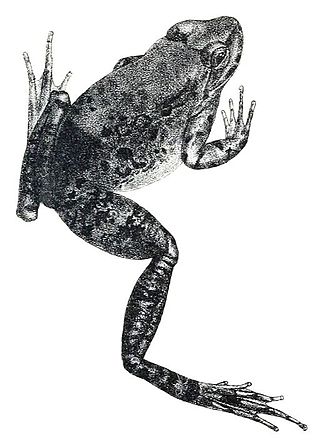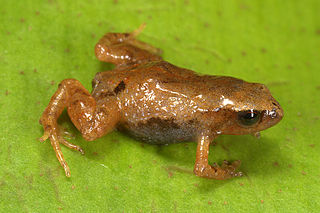
True frogs is the common name for the frog family Ranidae. They have the widest distribution of any frog family. They are abundant throughout most of the world, occurring on all continents except Antarctica. The true frogs are present in North America, northern South America, Europe, Africa, and Asia. The Asian range extends across the East Indies to New Guinea and a single species, the Australian wood frog, has spread into the far north of Australia.

Megophryidae, commonly known as goose frogs, is a large family of frogs native to the warm southeast of Asia, from the Himalayan foothills eastwards, south to Indonesia and the Greater Sunda Islands in Maritime Southeast Asia, and extending to the Philippines. Fossil remains are also known from North America. As of 2014 it encompasses 246 species of frogs divided between five genera. For lack of a better vernacular name, they are commonly called megophryids.

The southern frogs form the Leptodactylidae, a name that comes from Greek meaning a bird or other animal having slender toes. They are a diverse family of frogs that most likely diverged from other hyloids during the Cretaceous. The family has undergone major taxonomic revisions in recent years, including the reclassification of the former subfamily Eleutherodactylinae into its own family the Eleutherodactylidae; the Leptodactylidae now number 206 species in 13 genera distributed throughout Mexico, the Caribbean, and Central and South America. The family includes terrestrial, burrowing, aquatic, and arboreal members, inhabiting a wide range of habitats.

The Rhacophoridae are a family of frogs in tropical sub-Saharan Africa, South India and Sri Lanka, Japan, northeastern India to eastern China and Taiwan, south through the Philippines and Greater Sundas, and Sulawesi. They are commonly known as shrub frogs, or more ambiguously as "moss frogs" or "bush frogs". Some Rhacophoridae are called "tree frogs". Among the most spectacular members of this family are numerous "flying frogs".

The Arthroleptidae are a family of frogs found in sub-Saharan Africa. This group includes African treefrogs in the genus Leptopelis along with the terrestrial breeding squeakers Arthroleptis, and several genera restricted to the Guinean forests of central and west Africa, such as the hairy frog (Trichobatrachus).

The Rhacophorinae are a subfamily of frogs in the family Rhacophoridae. They range from tropical Africa and Asia to temperate China and Japan.

Rhacophorus is a genus of frogs in the shrub-frog family Rhacophoridae, which, with the related Hylidae, is one of the two genera of true tree frogs. They are found in China, India, Japan, and throughout Southeast Asia, including the island of Borneo. Over 40 species are currently recognised.

Fejervarya is a genus of frogs in the family Dicroglossidae found in Asia. First proposed in 1915 by István József Bolkay, a Hungarian naturalist, the genus did not see widespread adoption at first. As late as the 1990s it was generally included in Rana, but more recent studies have confirmed its distinctness.

Limnonectes is a genus of fork-tongued frogs of 91 known species, but new ones are still being described occasionally. They are collectively known as fanged frogs because they tend to have unusually large teeth, which are small or absent in other frogs.

Nanorana is a genus of dicroglossid frogs. They are found in Asia, from the Himalayan region of northern Pakistan and northern India, Nepal, and western China east to montane southern China and southeast to Myanmar, Thailand, Laos, and northern Vietnam. Common names of these frogs reflect the complex taxonomic history of the genus and include Yunnan slow frogs and High Himalaya frogs.

Sphaerotheca is a genus of frogs in the family Dicroglossidae. They can be found in South Asia. Molecular data suggest that they are closely related to Fejervarya. Ecologically, they are burrowing frogs.

Scutiger is a genus of toads in the family Megophryidae. Common name lazy toads has been coined for them. They occur in China, Burma, Nepal, and northern India in high-altitude habitats. Most are endemic to China.
Liurana medogensis, commonly known as Medog papilla-tongued frog or Medog eastern frog, is a species of frog in the family Ceratobatrachidae. It is found in Mêdog County, Tibet (China) and in Arunachal Pradesh, northeastern India. However, the records from India might represent another species, and the IUCN SSC Amphibian Specialist Group (2020) does not include them in the range of this species.
Ingerana reticulata is a species of frog in the family Dicroglossidae. As presently known, it is endemic to Mêdog County in southeastern Tibet, China, but its range might extend to northeast India, given the proximity of the border. Common names reticulate eastern frog, reticulate wrinkled ground frog, and reticulated papillae-tongued frog have been coined for it.
Liurana xizangensis is a species of frog in the family Ceratobatrachidae. It is endemic to Tibet, China, and only known from the region of its type locality, Yi'ong, in Bomê County. It is also known as Xizang eastern frog and Xizang papillae-tongued frog.

The Strabomantidae, sometimes called cloud forest landfrogs, are a family of frogs native to South America. These frogs lack a free-living larval stage and hatch directly into miniature "froglets". This family includes Pristimantis, the most speciose genus of any vertebrate.

Gracixalus is a genus of shrub frogs from south-eastern Asia.

Quasipaa is a genus of frogs in the family Dicroglossidae. The genus has no established common name, but many individual species are referred to as spiny frogs. They occur in East and Southeast Asia, from Thailand and Cambodia to southern and eastern China.

The Alsodidae are a small family of frogs from South America between Patagonia and southern Brazil. It contains 30 species in three genera. This family, along with several other families, used to be included in the family Leptodactylidae. It was then a subfamily in the family Cycloramphidae, before being recognized as a family first in 2011.

The Leiuperinae are a subfamily of frogs in the family Leptodactylidae. Over 90 species are in five genera. The distribution of this subfamily is from southern Mexico to the Central America and much of South America.

















